Lights attract moths, the fluttering and bopping creatures of the night. They wreak havoc on your clothes, carpets, and pantry. However, the good news is that you can fend off these pesky intruders using one of their own weaknesses: their keen sense of smell. Discover the smells that moths hate and how you can use them to keep them away. Say goodbye to holes in your favorite sweaters and pantry raids, and unlock the secrets of moth-repellent scents that will protect your home and belongings.
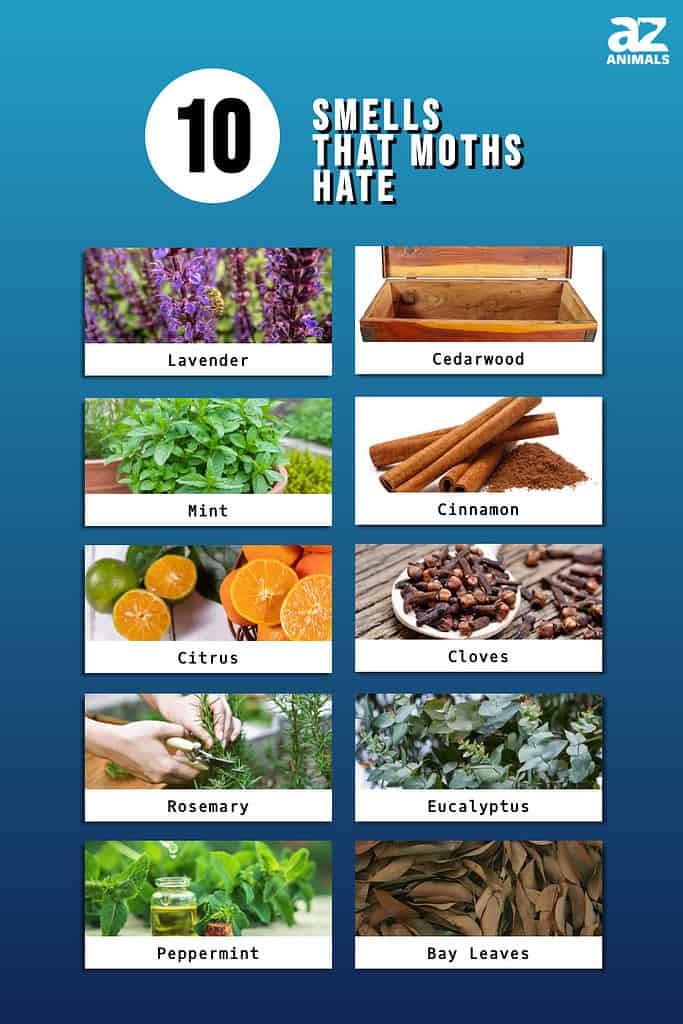
Three Common Moths
The three most common types of moths found in the United States are the following.
Indianmeal Moth (Plodia interpunctella)
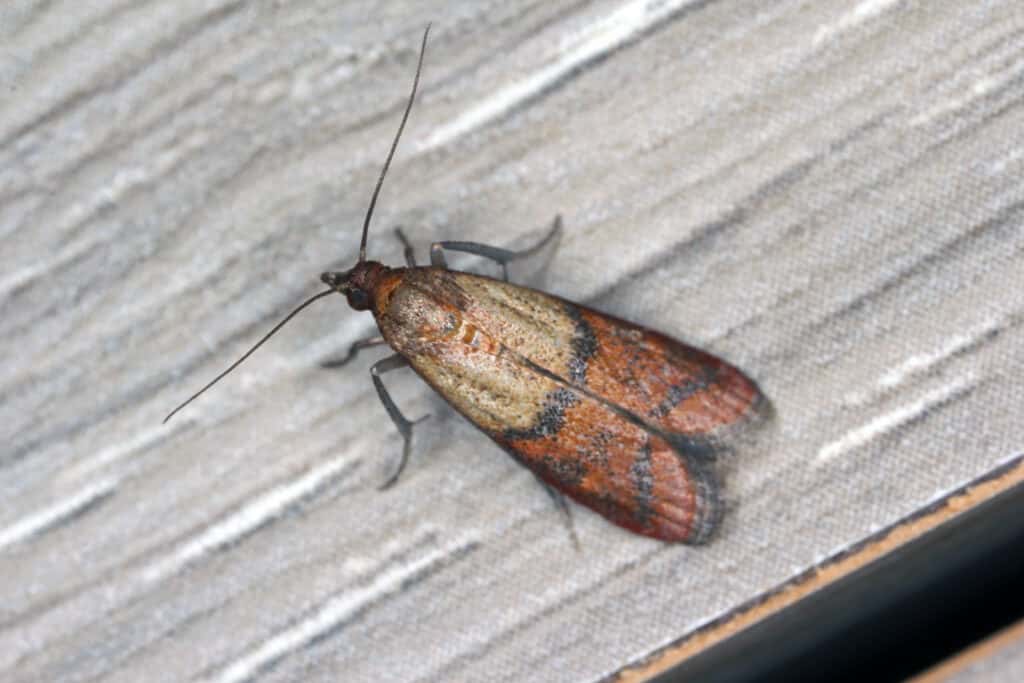
Indianmeal moths, also known as pantry moths, are famous for their ability to infest stored food products.
©Tomasz Klejdysz/Shutterstock.com
Find indianmeal moths in kitchens and pantries. They infest stored food products like grains, flour, nuts, and dried fruits. These moths have reddish-brown wings with a distinctive band of coppery-red at the outer ends.
Clothes Moth (Tineola bisselliella)
Clothes moths infest clothing and textiles made from natural fibers such as wool, silk, and fur. They are small and golden in color and are often responsible for damaging clothing and household items.
Gypsy Moth (Lymantria dispar)
The gypsy moth is an invasive species and a significant forest pest. Its larvae defoliate trees, particularly oaks and other hardwoods. These moths are also responsible for significant damage to forests in many parts of the United States.
10 Smells That Moths Hate
1. Lavender
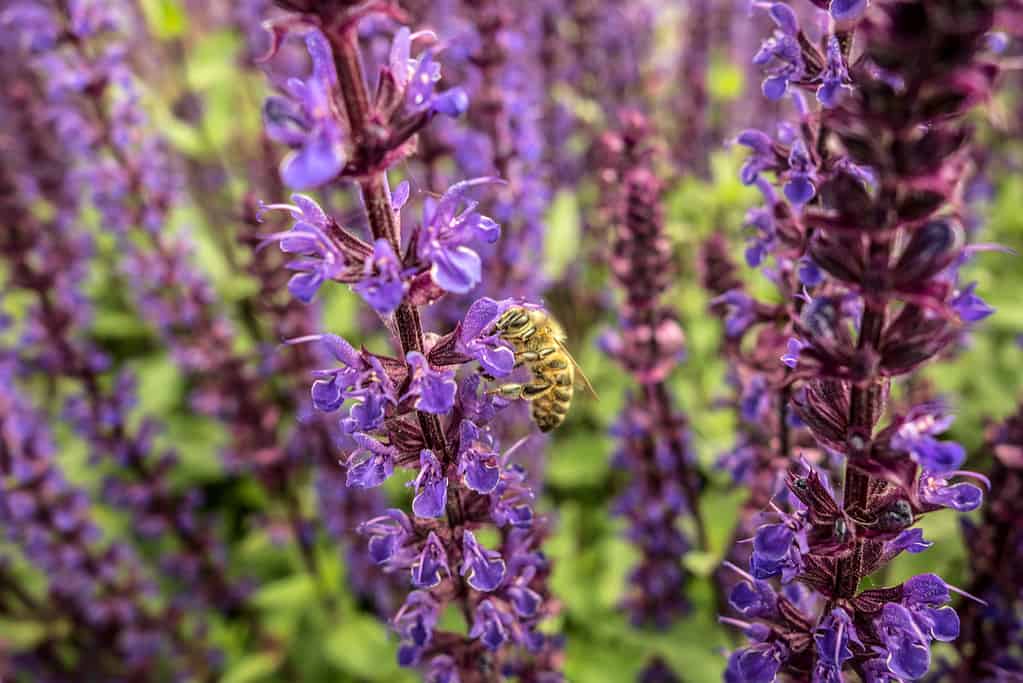
Lavender repels moths and is known for its stress-relief properties and pleasant aroma.
©ivanoel28/iStock via Getty Images
Lavender has an enchanting aroma and color. It is a favorite among humans but a dreaded scent for moths. These winged intruders despise the sweet, floral fragrance of lavender, making it a top choice for those looking to fend off moths naturally.
How to Use Lavender to Deter Moths
Harness lavender in various forms to deter moths effectively. Lavender sachets are a popular choice. Simply place these sachets in your closets, drawers, or anywhere you store clothing, linens, or textiles. The scent will not only keep moths away but also infuse your belongings with a delightful, calming aroma.
You can also harness the power of essential oils. A few drops of lavender essential oil on cotton balls placed strategically in moth-prone areas effectively keep your space pest-free. Additionally, you can add a few drops of lavender oil to your laundry to protect your clothes from moth damage.
Lastly, consider planting lavender in your garden. Not only does it make your outdoor space more attractive, but it also creates a natural barrier against moths. The scent of lavender in your garden can help keep moths at bay and prevent them from entering your home.
2. Cedarwood

Cedarwood boxes, closet inserts, and even outdoor furniture effectively repel pests, including moths and mosquitoes.
©Noel V. Baebler/Shutterstock.com
Cedarwood, a fragrant and naturally moth-repelling wood, has been used for centuries to protect clothing and linens from these destructive insects. Moths find the scent of cedarwood highly unappealing, making it a timeless and effective choice for moth prevention.
How to Use Cedarwood to Deter Moths
There are several ways to harness the power of cedarwood to deter moths. Cedarwood blocks or balls are a classic choice. Place these in your closets, drawers, or storage containers to create a protective barrier around your clothing and textiles. The cedar aroma will keep moths at bay while leaving your belongings with a subtle woody scent.
Additionally, cedar-lined closets offer a more comprehensive approach. If you have the opportunity to install cedar lining in your closet, it can provide moth protection for an entire storage space. The continuous release of cedar scent in such an environment ensures that moths won’t dare to venture near your cherished items.
Essential cedarwood oil is another versatile solution. Like lavender oil, a few drops of cedarwood essential oil on cotton balls can be tucked into corners, or you can refresh your cedar blocks and sachets by adding a drop or two of the oil. This maintains their moth-repelling properties over time.
One of the remarkable aspects of cedarwood is its longevity. Unlike many other moth repellents, cedarwood retains its effectiveness for a long time. Furthermore, periodically sanding or scraping the surface of your cedar products can revive the scent and maximize their protective abilities.
3. Mint
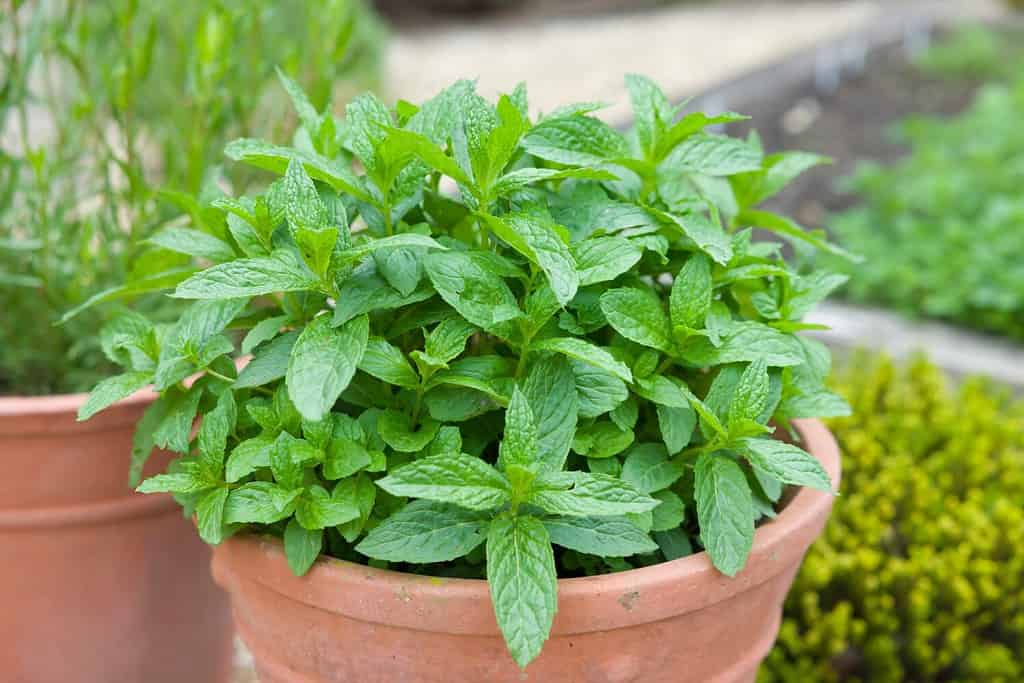
Mint is a hardy herb that can thrive and even spread rapidly in various garden conditions, making it a popular choice for novice and experienced gardeners.
©Paul Maguire/Shutterstock.com
Mint produces an invigorating and fresh aroma that is also a natural enemy of moths. The strong smell repels these winged nuisances, making it a potent ally in your battle against moth infestations.
How to Use Mint to Deter Moths
Emply mint in various forms to create a hostile environment for moths. Use mint leaves in sachets placed in closets, drawers, or storage containers. The scent of mint not only keeps moths away but also infuses your belongings with a pleasant, crisp aroma.
Additionally, mint essential oil is another versatile option. A few drops of mint essential oil on cotton balls deter moths from the area. Furthermore, you can also add a few drops of mint oil to your laundry to protect your clothing from moth damage, similar to lavender oil.
Consider planting the culinary herb in your garden or pots indoors. Mint’s potent fragrance outdoors can act as a natural barrier, preventing moths from entering your living spaces. Apart from its effectiveness as a moth repellent, mint has the added benefit of being useful in culinary and herbal remedies. You can enjoy fresh mint in your teas and recipes while knowing it’s keeping moths at bay.
4. Cinnamon
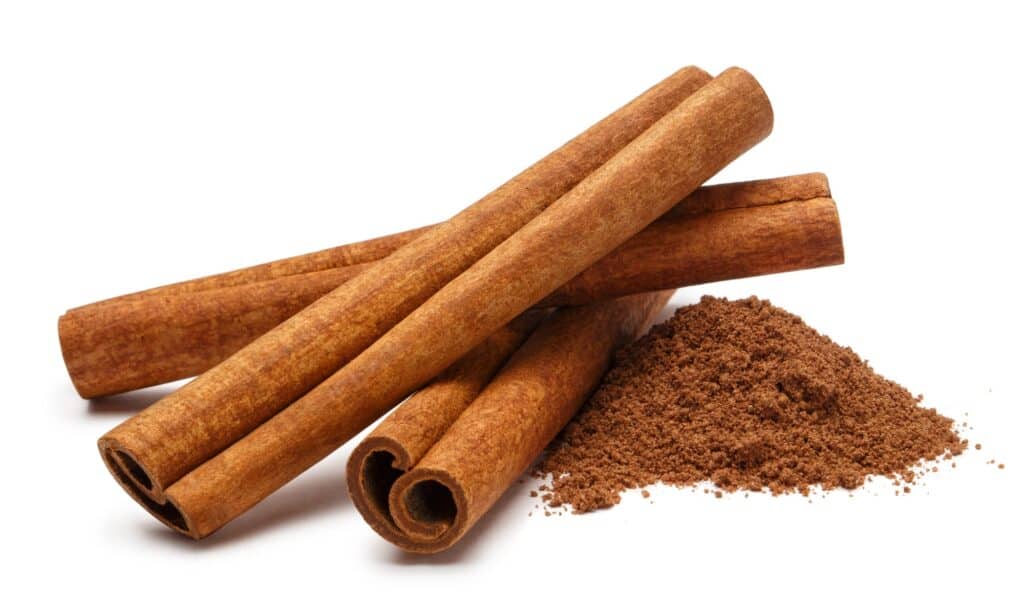
Cinnamon has a long and storied history as a valuable commodity that once rivaled gold in trade value during ancient times.
©iStock.com/Marat Musabirov
Cinnamon’s warm and spicy aroma is a natural moth repellent that adds a delightful twist to your anti-moth arsenal. Moths find the scent of cinnamon unappealing, making it an effective choice for safeguarding your belongings from these pesky insects.
How to Use Cinnamon to Deter Moths
There are several creative ways to use cinnamon to deter moths. Place cinnamon sticks or powdered cinnamon in moth-prone areas. These can include closets, drawers, or storage containers for clothing and textiles. The scent of cinnamon acts as a protective shield, making moths think twice about invading your space.
Homemade sachets filled with cinnamon and other moth-repelling ingredients are also a charming addition to your storage areas. Simply combine cinnamon with other fragrant herbs and spices in small cloth bags and hang or place them where moths are a threat.
Furthermore, cinnamon also offers an excellent solution for protecting your pantry. Place cinnamon sticks or sprinkle cinnamon powder around your pantry shelves to deter pantry moths from invading your food supplies. The comforting scent of cinnamon is not only a moth deterrent but also a welcoming and cozy addition to your living spaces. By using cinnamon as a moth repellent, you not only keep your belongings safe but also fill your home with the delightful fragrance of this popular spice.
5. Citrus

Citrus fruits are not only delicious but are also rich sources of vitamin C and antioxidants, making them vital for a healthy diet.
©Murilo Mazzo/Shutterstock.com
Vibrant and zest, citrus serves as a natural moth repellent. These winged pests find the sharp, fresh scent of citrus fruits like lemons and oranges highly unappealing, making it an effective choice for keeping moths at bay.
How to Use Citrus to Deter Moths
There are several creative methods to utilize citrus as a moth deterrent. Start by saving citrus peels after you have enjoyed the fruit. Place these peels in your closets, drawers, or storage containers. Not only will they keep moths away, but they will also add a refreshing, invigorating scent to your belongings.
Citrus essential oils are another powerful option. Add a few drops of citrus essential oil, like lemon or orange, to cotton balls and place them in moth-prone areas. You can also use these oils to refresh citrus peels, ensuring they remain effective over time.
Lastly, create a moth-repelling potpourri using citrus peels, dried herbs, and spices. This blend not only keeps moths at bay but also offers a delightful fragrance throughout your living spaces. Citrus is a natural and effective choice for moth prevention.
6. Cloves
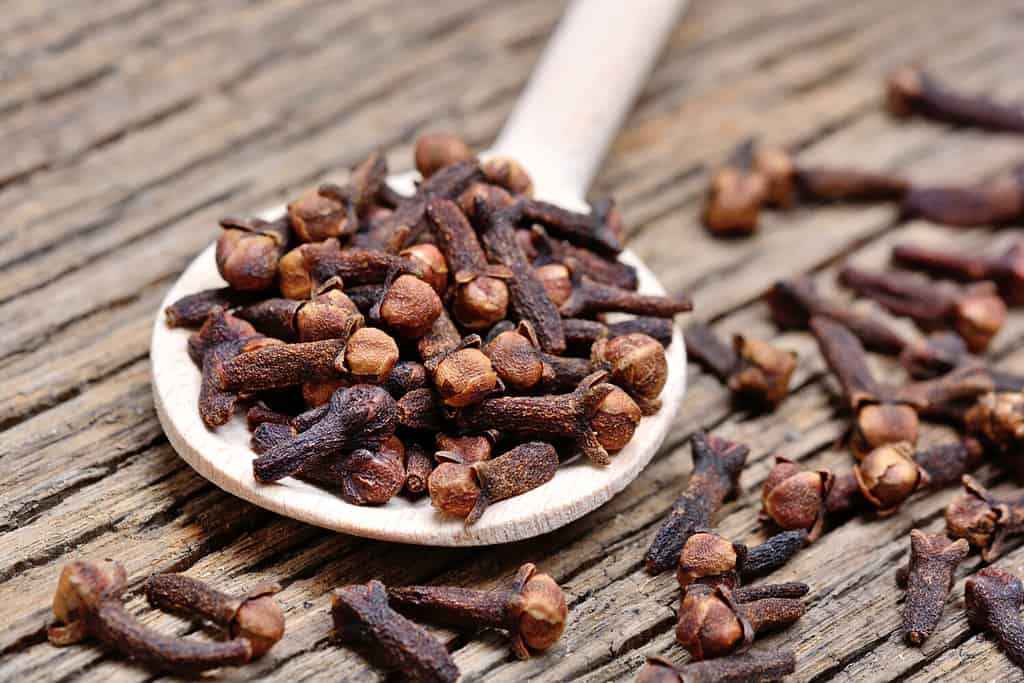
Beyond its pungent aroma, cloves have been prized for their medicinal properties, offering pain relief and dental benefits.
©DeeaF/Shutterstock.com
Cloves, known for their intense, pungent aroma, are a natural moth repellent that can keep these unwelcome guests away. Moths find the spicy scent of cloves highly disagreeable, making them an effective choice for protecting your clothing and textiles.
How to Use Cloves to Deter Moths
Harness cloves in several ways to create a moth-repelling environment. Place whole cloves inside sachets, small cloth bags, or directly in closets, drawers, or storage containers. The strong, aromatic presence of cloves acts as a barrier against moths, discouraging them from invading your space.
Clove essential oil is another versatile option. Like other oils, add a few drops to cotton balls. This method ensures a continuous release of the clove scent, effectively repelling moths.
You can also opt to create a homemade potpourri with dried cloves, aromatic herbs, and spices. Not only will it keep moths away, but it will also fill your storage areas with a pleasant, spicy aroma. The intense scent of cloves adds an extra layer of defense against moth infestations, making them an excellent choice for moth prevention.
7. Rosemary

Rosemary, celebrated for its herbal fragrance, has historical associations with love, loyalty, and memory enhancement.
©iStock.com/Artfully79
Rosemary has a strong, herbal scent, making it a natural moth-repellent that adds a touch of green freshness to your moth-fighting strategy. Moths find the aromatic fragrance of rosemary unappealing, making it a natural choice for safeguarding your belongings.
How to Use Rosemary to Deter Moths
Place rosemary sprigs in closets, drawers, or storage containers. Their refreshing, herbal aroma not only keeps moths away but also adds a pleasant, garden-like scent to your belongings. Furthermore, rosemary essential oil is another versatile option. A few drops of rosemary essential oil on cotton balls positioned in areas prone to moth infestation can keep the pests away and provide continuous protection.
Additionally, consider creating sachets filled with dried rosemary, lavender, and other fragrant herbs. Hang these sachets in your closets or place them in storage areas for an effective, all-natural moth deterrent.
Lastly, plant rosemary in your garden. Harvest sprigs for culinary use or dry them in the other moth-repellent strategies. Rosemary not only offers moth-repelling properties, but it is also a versatile culinary herb.
8. Eucalyptus

Eucalyptus trees are an integral part of Australia’s ecosystem and serve as the primary diet for the iconic koala.
©iStock.com/Marina Denisenko
Eucalyptus produces a menthol-like aroma. It is a natural moth repellent that moths strongly dislike. This unique scent provides an effective barrier against moths, protecting your clothing and pantry.
How to Use Eucalyptus to Deter Moths
There are several ways to harness the power of eucalyptus to deter moths. Use eucalyptus leaves in sachets. The scent of eucalyptus not only keeps moths away but also leaves your belongings with a refreshing aroma.
Additionally, eucalyptus essential oil is another potent choice. Add a few drops of eucalyptus essential oil to cotton balls. You can also use these oils to refresh eucalyptus leaves or sachets, ensuring their effectiveness over time.
Furthermore, consider planting eucalyptus in your garden or pots indoors. Eucalyptus acts as a natural moth-repellent outdoors but also adds a touch of greenery to your surroundings.
It is a natural and refreshing choice for protecting your clothing, linens, and textiles from moths and also infuses your storage areas with a cool, invigorating fragrance. Overall, eucalyptus is a unique and effective option for moth prevention.
9. Peppermint

Peppermint’s cool and refreshing flavor extends to its uses in soothing teas, aiding digestion, and offering relief from headaches.
©Tatevosian Yana/Shutterstock.com
Peppermint also produces a fresh and invigorating aroma, similar to mint, that serves as a natural moth repellent. The strong scent of peppermint is highly unappealing to moths, making it a potent choice for keeping your space pest-free.
How to Use Peppermint to Deter Moths
Start by using peppermint leaves in sachets. Place the sachets in closets, drawers, and storage containers. Don’t forget to place a few in your pantry. The scent of peppermint not only deters moths but also leaves your belongings with a refreshing and cool aroma. It’s a win-win.
Peppermint essential oil is also a versatile option. Just squirt a few drops of the essential oil on cotton balls. Next, place the cotton balls in areas prone to moth infestations. This ensures that the area remains protected.
Like other culinary herbs, plant specimens in your garden or indoor pots. This versatile herb not only offers moth-repelling properties but also adds a refreshing and invigorating touch to your living spaces. You can protect your belongings but also enjoy the cool and stimulating essence of this beloved herb in teas and desserts.
10. Bay Leaves
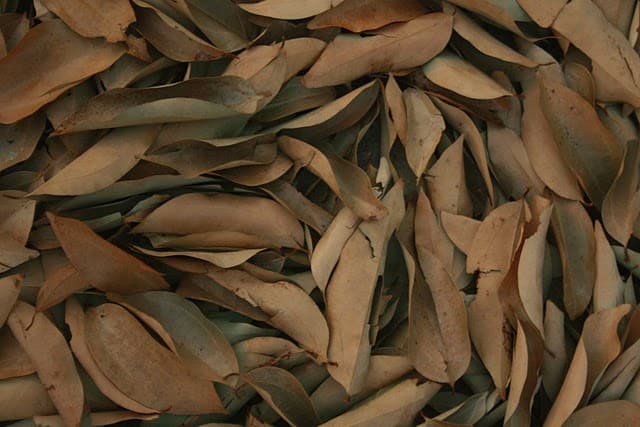
Bay leaves hold cultural significance as symbols of wisdom, protection, and victory while contributing a delightful aroma to Mediterranean cuisine.
©Sagar.kolte, CC BY-SA 3.0 , via Wikimedia Commons – License
Bay leaves have culinary uses and an aromatic and slightly pungent scent. The natural moth repellent also effectively keeps unwanted insects away. Moths find the scent of bay leaves unattractive, making them an excellent choice for safeguarding your home.
How to Use Bay Leaves to Deter Moths
Place whole bay leaves in storage containers for dried goods, such as grains, flour, and rice. The scent of bay leaves acts as a barrier against pantry moths, preventing them from infesting your food supplies.
Additionally, place bay leaves inside of homemade sachets. Then, place these sachets in your closets and drawers. You can also combine the bay leaves with other fragrant herbs and species like whole cloves, lavender, basil, or eucalyptus to provide a natural and aromatic moth repellent.
Bay leaves not only offer moth-repelling properties but also have culinary uses. They infuse soups, stocks, and stews with their flavorful aroma. Ultimately, they are a versatile and aromatic choice for moth prevention.
Summary: 10 Smells That Moths Hate
| Number | Source of Smell | How To Use |
|---|---|---|
| 1 | Lavender | Containers or sachets, essential oils, planted |
| 2 | Cedarwood | Containers, cedar-lined areas, essential oils |
| 3 | Mint | Containers or sachets, essential oils, planted |
| 4 | Cinnamon | Containers or sachets, spread powdered cinnamon |
| 5 | Citrus | Placed peels, essential oils, potpourri |
| 6 | Cloves | Containers or sachets, essential oils, potpourri |
| 7 | Rosemary | Containers or sachets, essential oils, planted |
| 8 | Eucalyptus | Containers or sachets, essential oils, planted |
| 9 | Peppermint | Containers or sachets, essential oils |
| 10 | Bay Leaves | Containers or sachets |
The photo featured at the top of this post is © Cosmin Manci/Shutterstock.com
Thank you for reading! Have some feedback for us? Contact the AZ Animals editorial team.






